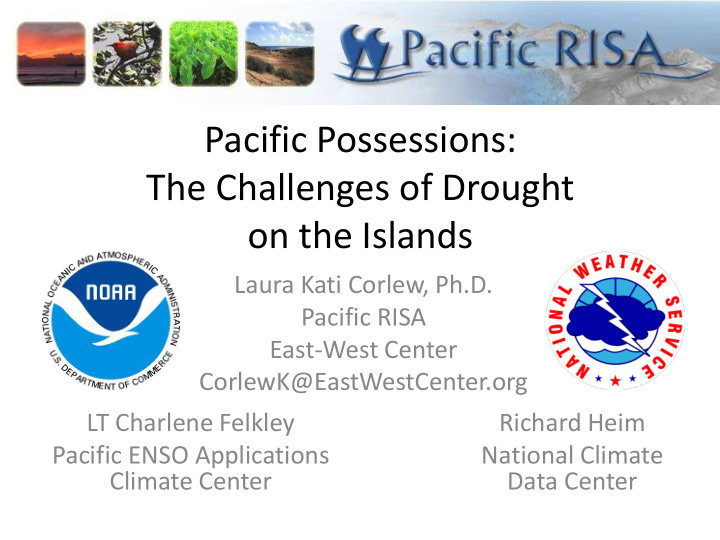



Pacific Possessions: The Challenges of Drought on the Islands Laura Kati Corlew, Ph.D. Pacific RISA East-West Center CorlewK@EastWestCenter.org LT Charlene Felkley Richard Heim Pacific ENSO Applications National Climate Climate Center Data Center
Pacific RISA Regional Integrated Sciences and Assessments
Pacific Islands Regional Climate Assessment (PIRCA) http://www.pacificrisa.org/projects/pirca/report-materials
The MISSION of the Pacific ENSO Applications Climate Center is to conduct research and develop information products specific to the USAPI on the ENSO climate cycle, its historical impacts, and latest long-term forecasts of ENSO conditions, in support of planning and management activities in such climate-sensitive sectors as water resource management, fisheries, agriculture, civil defense, public utilities, coastal zone management, and other economic and environmental sectors of importance to the communities of the USAPI.
PEAC’s Main Collaborators The National Oceanic and Atmospheric Administration (NOAA), the National Weather Service (NWS) Pacific Region, the University of Hawaiʻi – JIMAR, and the University of Guam – Water and Environmental Research Instituted (UOG/WERI). Additional Partnerships: NOAA Climate Program Offices (NOAA/CPO), the NOAA Climate Prediction Center (NOAA/CPC), and the International Research Institute for Climate and Society at Columbia University (IRI)
The Pacific Region
PEAC Center affects the livelihoods of more than two million people, speaking fourteen different languages, spread out over ten million square miles in Hawaiʻi and the US Affiliate Pacific Islands (USAPI).
PEAC’s Monthly Conference Calls • PEAC-sponsored call in an hour-long workshop format • WSO from each of the island communities is invited to attend to discuss: – PEAC forecasts (sea-level, rainfall, tropical cyclone, etc.) – Issues related to past, present, and future climatic conditions CONSENSUS FORECAST: – Based on observations provided by the WSO representatives – Rainfall, sea-level, and tropical cyclone forecasts for each zone – Forecasts expressed as probabilities of occurrence
• Quarterly Newsletter • Sea-level, rainfall summaries and forecasts for American Samoa, CNMI, FSM, Guam, Hawaiʻi, Palau, and RMI • Special section in each issue discusses tropical cyclone outlook, SOI, SST and sea-level forecasts • Published every 3 months (with special bulletins issued as needed) • About 500 hardcopies are mailed worldwide • Electronic versions of the newsletter are available at http://www.prh.noaa.gov/peac/
Climate Impacts and Outlooks
Defining Drought in the Pacific Region There are a number of island-specific impacts that could potentially • be used as indices of drought associated with the ENSO cycle. E.g., food and water security • Despite a clear understanding of ENSO impacts on the islands, • especially in relation to drought impacts, there remain only a few drought indices available in the Pacific.
High Islands vs. Low Islands The higher islands typically have stream flow, aquifers, and • catchments to meet water needs. Rainclouds gather at mountain peaks. • Watersheds run from the upland ecosystems down to coastal areas. • During droughts, the uplands suffer from lack of moisture from the • cloud cover and stream flow diminishes. Water stores in the aquifers and catchment tanks dwindle.
High Islands vs. Low Islands • On the lower islands, there is no stream flow, and aquifers – if they exist – are small and brackish. • Catchments become the sole source of water supply. • There are only two reservoirs in the USAPI used for drinking water, located in Guam and Palau.
Challenges of drought monitoring in the Pacific Drought is defined differently in the USAPI than the mainland • Atolls lacking streams • Very little agriculture
Challenges of drought monitoring in the Pacific • Need for clearly defined objective as well as subjective indicators specific to each group of islands. • Without quantifiable data, the USDM in the Pacific Islands will not be significant. – Note: we do have SPI established for most of the islands in our network.
Challenges of drought monitoring in the Pacific Weather extremes are more frequent, more destructive, and more relevant in the changing climate.
Challenges of drought monitoring in the Pacific In Kosrae, 1997 was the wettest year on record, while the following year in 1998 was the driest.
Challenges of drought monitoring in the Pacific Need to obtain a better understanding of the impacts and atmospheric drivers of drought in the Pacific Islands.
Challenges of drought monitoring in the Pacific • Although a meteorological drought is over when rains finally arrive, an island community’s food sources can take 8-10 months more to recover. • Additionally, heavy rains due to a tropical storm system may dump a large amount of rain at one time, but may not necessarily end a drought.
Challenges of drought monitoring in the Pacific Real time data is limited in many of the USAPI. • Insufficient data monitoring stations • Logistical issues in very remote areas—travel and technology • Turnover and replacement of employees with long training periods affects information distribution • Language and cultural diversity in communication
Experimental drought monitoring in the Pacific
Future of drought monitoring in the Pacific Clearly define objective and subjective indicators and impacts for each island community. Include number of days since last X” rainfall for each island community.
Future of drought monitoring in the Pacific Transition monthly climate information sharing can transition to weekly information sharing to work with the USDM established drought monitoring system. Automate daily precipitation.
Thank You! Mahalo Nui Loa! Kati Corlew, Pacific RISA Fa’afetai Lava! CorlewK@EastWestCenter.org Kommol Tata! Kinisou! Charlene Felkley, PEAC Kalahngan! PEAC@noaa.gov Kulo! Kammagar! Richard Heim, NCDC Si Yu’us Ma’ase! Richard.Heim@noaa.gov Ke Kmal Mesaul!
Recommend
More recommend